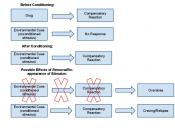In an essay of 2500 words, explain and discuss behaviour modification, giving some examples of how it might be used in the treatment of criminals.
In this essay I am going to define behaviour modification. I will discuss the traditional approaches of operant and classical conditioning and then look at the modern approaches of behaviour modification. I will also give some examples of how behaviour modification can be used in the treatment of criminals.
Behaviour modification, also known as behaviour therapy, is a process whereby observable behaviour patterns can be changed by using psychological methods. Anything that can change the way a person feels or acts can be a means of altering behaviour. In simple terms, behaviour modification is a process where bad behaviour is punished, or associated with punishment, and good behaviour is rewarded, or associated with reward. The procedures used are monitored so that changes can be made if needed.
Punishment can be defined as the response ""contingent application of an unpleasant or aversive event in an attempt to suppress, or prevent the recurrence of, that response. It is response-contingent because the punishment is supposed to occur if the unacceptable response occurs.
Ian Pavlov developed the foundation for modern behaviour modification approaches through his work with conditioned reflexes in dogs. Through his research and experiments he showed that a dog could be conditioned to salivate when a bell was rung. Pavlov experimented further and performed experiments in which a dog was trained to salivate when the image of a circle was projected on a screen, but when an ellipse was shown it was trained not to respond. When this was established the shape of the circle was gradually changed towards an ellipse. As the circle was changed the dog showed signs of agitation and lost the response...


